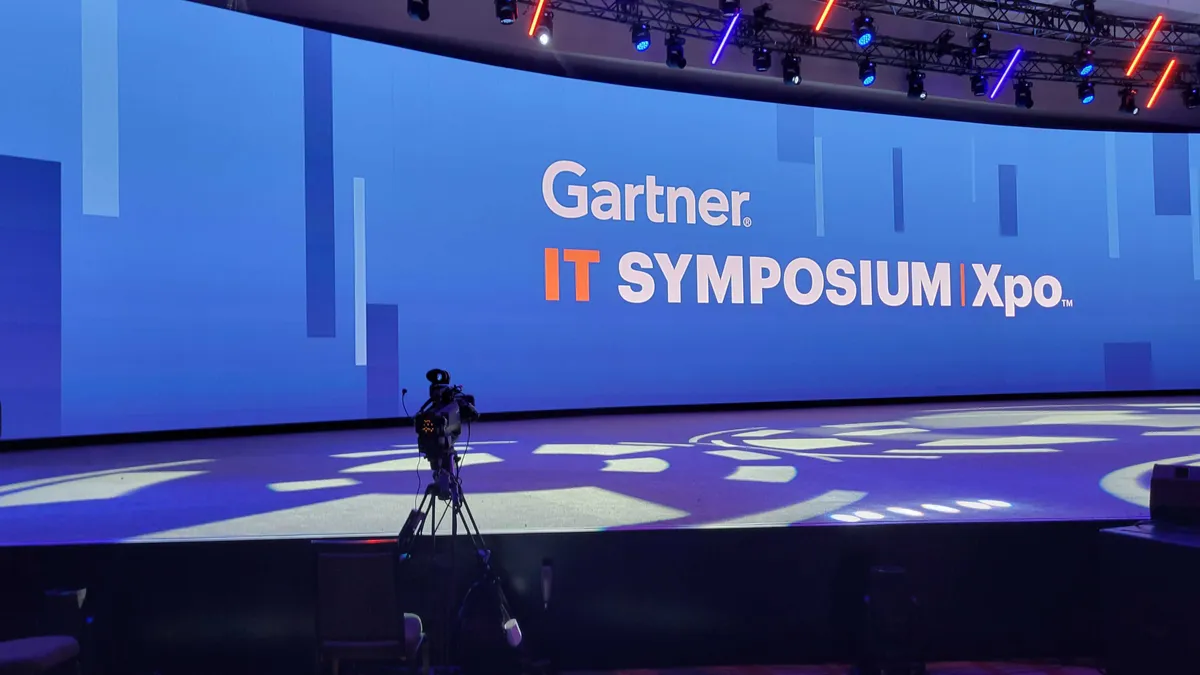ORLANDO, Fla. — The pandemic pushed CIOs to innovate on the fly. It was technology that let business pivot to remote and hybrid work, stay connected to customers and manage supply chain troubles.
Now, with a new suite of challenges encroaching, a rethink is in order.
Rising interest rates coupled with high inflation led to corporate belt tightening. An ongoing tech talent crunch has emphasized the need for workforce retention and automation. And consolidation in cloud is solidifying the market dominance of hyperscalers.
Daryl Plummer, VP, distinguished analyst and Gartner Fellow, outlined predictions related to workforce, emerging tech and cloud strategy that should be on the forward-thinking CIO’s radar at the Gartner IT Symposium/Xpo on Tuesday.
Economic uncertainty and its impact on growth is a top concern for C-suite execs, according to the analyst firm.
Challenging basic assumptions about the limitations and possibilities of the tech-empowered enterprise are key to finding opportunity in uncertainty, Plummer said.
Here are six predictions impacting the role of the CIO pulled from Gartner’s top-ten list:
Through 2027, fully virtual workspaces will account for 30% of investment growth by enterprises in metaverse technologies.
Currently, VR is primarily a domain for gamers and even the latest iteration of Oculus is bulky and “goofy looking,” Plummer said.
But the technology is improving, and by 2027 the metaverse and immersive VR will be integrated into the daily workplace experience, Gartner predicted.
Fueled by workforce shortages and demand for flexible employment, companies will adopt VR as a talent recruitment and retention measures, as well as to augment capabilities.
This “reimagining” will level the playing field for remote workers, creating a virtual space that doesn’t implicitly favor employees who have the advantage of being on site, Plummer said.
VR will also enhance collaboration. Plummer described a scenario in which three oil engineers meet in a virtual space simulating a drill site on the ocean floor as an example of what Gartner believes will be possible in four years.
By 2025, organizations that remediate gender pay gaps will decrease women's attrition by 30%, reducing talent shortages.
The Great Resignation has pushed companies to reevaluate salary disparities. Pressure to retain talent will push more companies to eliminate gender pay gaps, according to Gartner.
A new approach to gender equity will require better metrics to measure inequalities and encourage transparency, Plummer said. “If you can’t identify the problem, you can’t address it,” he said.
In addition to mitigating talent pressures, salary equity will reduce toxic work culture, Plummer said.
By 2025, ‘labor volatility’ will cause 40% of organizations to report a material business loss, forcing a shift in talent strategy from acquisition to resilience.
As labor shortages impede modernization and impact the bottom lines, recruitment will give way to a new way of thinking about the tech workforce, according to Gartner.
Companies are already looking to upskill current staff. The next logical step is to cultivate versatility, said Plummer.
The goal will be to hedge against labor shortages by upskilling staff in more than one area so that they can cover for one another and fill in gaps when needed.
“As people become more versatile in their skill set, they are more valuable to the company and less likely to leave,” Plummer said.
Through 2025, employee value metrics like wellbeing, burnout and brand satisfaction will override ROI evaluations in 30% of successful growth investment decisions.
Another byproduct of the Great Resignation will be a more rigorous approach to evaluating and addressing wellbeing, burnout and job satisfaction.
Productivity, efficiency and cost are already tied to actionable metrics. Human factors will be next.
Employers will have to be empathetic and more responsive to these issues because “it’s too easy for people to leave and find work at another company,” Plummer said. “Remote work has made that a reality.”
Through 2025, powerhouse cloud ecosystems will consolidate the vendor landscape by 30%, leaving customers with fewer choices and less control of their software destiny.
M&A activity in the cloud software market has been on the rise, a trend that is likely to continue, according to Gartner.
As consolidation mounts, cloud customers will be left with fewer vendor choices.
To prepare, CIOs should choose a default cloud vendor using ecosystem coherence as a primary partnering criteria, said Plummer.
Leveraging open source options and joining a customer lobby are other measures that may also prove helpful, but cloud customers will have to make tough choices between best-of-breed technologies and assets that are good enough for specific use cases.
By 2025, without sustainable practices, AI will consume more energy than the human workforce, significantly offsetting carbon zero gains.
AI, ML and BI technologies are helping achieve efficiency gains and, in some cases, reduce waste, carbon emissions and environment damage.
But AI needs compute and that means power — a dynamic that will eat away at sustainability gains unless better AI practices are adopted.
Many AI applications already consume more calories per day than human beings, Plummer said. Unless that consumption is checked it will be bad news for the climate.
CIOs should focus on economizing data stores and using AI to predict and reduce carbon emissions, according to Plummer. And, yes, that may mean using AI to optimize AI.






















